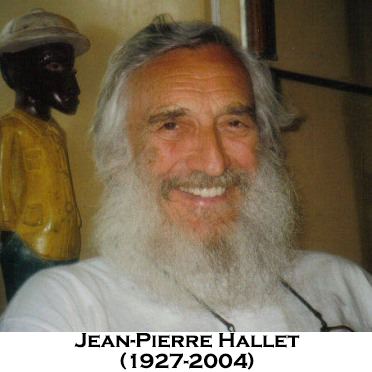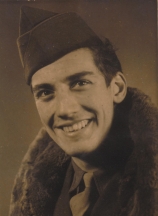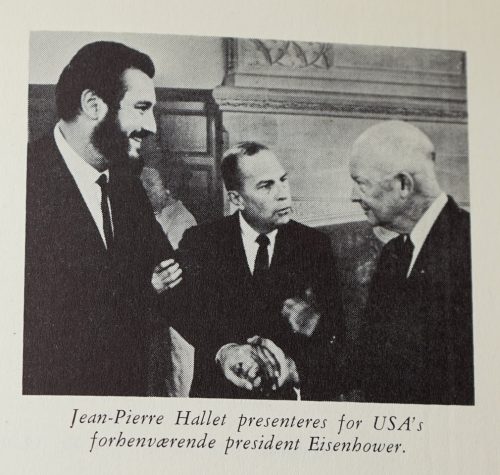
Jean-Pierre Hallet
Explorer • Socialist • Naturalist • Author • Lecturer
Jean-Pierre Hallet was a man more intimately connected to Africa than perhaps any other westerner. His feats were legendary-what one expects of fiction and adventure movies. About his mission to save the vanishing Bambuti pygmy tribe in the Ituri Forest in Northeast Zaire, the newspapers and magazines of three decades reported it in various ways. He Saves Little People; A Giant Comes To The Rescue; He’s The Biggest Of The Little People of Zaire; Humanitarian Sows Seeds of Hope and Pygmies Have A Friend in Hallet.
Dr. Hallet and his family ran one of the largest authentic Central African art shops in the United States at the Third Street Promenade in Santa Monica, California, near Los Angeles, until the late 1990s.
Proceeds from these art sales were used to benefit the Efé pygmies.
The collection of art that he collected during the described journeys in the book Congo Kitabu eventually became a large portion of the UCLA African Art premier exhibit in 1963 – 1965, when Dr. Hallet donated much of it to the university. This collection is now part of the UCLA Fowler museum.
Jean-Pierre Hallet Collection of African Art
Jean-Pierre amassed a vast collection of African art during his travels and professional activities. A large part of his personal collection, considered one of the world’s greatest, was effectively donated to UCLA in 1963. His collecting urge reached out to Tanzania, southern and western Africa and other regions, resulting in a second fabulous collection, which literally filled every room of his home in Malibu, California.
THE LEGEND

Jean-Pierre Hallet died on January 1, 2004, at the age of 76. He was internationally renowned as an africanist, ethnologist, sociologist, humanitarian, agronomist, naturalist, author, lecturer, explorer, photographer, cinematographer, artist, African art authority and collector, and death-defying adventurer. He was best known and revered, however, as the world authority on the culture, languages, and history of African pygmies in general and the Ituri Forest Efé clan of the Bambuti pygmies in particular.
Jean-Pierre was the creator and driving force behind The Pygmy Fund, the only organization devoted solely to the preservation of the lives and culture of surviving forest-dwelling Efé pygmies. Numerous organizations can be found to protect and assure the perpetuation of rare and endangered animals and plants. But none exists with a similar objective of protecting rare and endangered human ethnic societies. The Ituri Forest Efé pygmies occupy less than 1% of the land preserved for African wildlife. Their numbers have been reduced over the past 75 years from 35,000 to about 3,000 individuals. They are subjected to enslavement and endangered by the destruction of the pristine Congo forest on which their lives depend.
African pygmies were, in Jean-Pierre’s view, especially deserving of our concern and protection. Their former widespread distribution and historical and cultural importance were a focus of his scholarly studies. These established that the African pygmies are the most ancient surviving human race (since confirmed by DNA and genetic studies) and have unique cultural and linguistic characteristics. Without their protection there would be an irreparable loss of a basic branch of humankind that has much to teach us, as Hallet established in his final published book, Pygmy Kitabu (Random House, 1973). His extensive knowledge of the pygmy language resulted in a dictionary of some 18,000 terms, which unfortunately was never published.
The last 45 years of Jean-Pierre Hallet’s life were devoted to ensuring the survival of the Efé. His boundless energy and confidence, along with his personal resources, were dedicated to that cause. His earliest memories were playing with pygmy children north of Lake Kivu, in the northeastern part of the former Belgian Congo. His father, the famed “Artist of the Congo”, André Hallet, lived and painted along the northern shore of Lake Kivu, in the adjoining mandated territory of Ruanda-Urundi (divided into Rwanda and Burundi after independence). His work was widely recognized and his paintings of Congo scenes and portraits hang in galleries throughout Europe, Japan, and the US. André´s energy and output were prodigious with over 5,000 paintings completed in 50 years. André´s equally famed volcanic temper and great sensitivity surely influenced the development of the child. Jean-Pierre remained in Africa until age 6, living among pygmy and Bantu children, dressing and living as they did. Speaking only their languages and refusing to speak French, he was consequently sent to Belgium at age 6 for a “proper” European education, living with his aunt. During World War II he fought with the resistance at ages 15 and 16 (1942 and 43), and with the Belgium army, 1944-45, receiving several medals for valor. He was educated as an agronomist and sociologist at the University of Brussels, 1945-46, and the Sorbonne, 1947-48. His intent and purpose were to return to Africa to work with the local tribes-people, among whom he had spent the happiest years of his life. He therefore joined the Ministry for Colonies as an agronomist to work in the former Belgian Congo (1948-58).
A deep love and understanding of pygmy society, of their peaceful qualities, gentleness, family devotion, and their intimate knowledge and respect for their forest environment developed in Jean-Pierre during the 18 months he spent at ages 30 and 31 as an adopted member of the Efé tribe. It began with his near-death from a pygmy’s poisoned arrow, and his subsequent rescue by the chief and witchdoctor of the people attempting to defend their encampment. The chief cut deeply into his upper leg (without anesthesia) allowing blood to drain along with the poison. Jean-Pierre somehow survived the usually incurable neurotoxin that had entered his leg with the pygmy arrow. The story of this period is related in the first of his 3 books, the autobiographical Congo Kitabu (Random House, 1964).

In the years from 1950 to 1957, between the age 23 to 30, Jean-Pierre was initiated into a number of African tribal secret societies, making him a blood-brother of the Lega (Bwama Secret Society), the Masai, the Tutsi (Watutsi), and the Nande. The Masai initiation is one that few non-Masai would dream of attempting: to kill a charging lion with a spear while enclosed within a circle of Masai warriors. This, he somehow accomplished with a combination of bravado, strength, determination and discipline, all characteristics that typified his entire life.
Among his hairbreadth escapes —19 near-death experiences prior to his 2-year final fatal bout with leukemia— one life-determining episode remains a testament to his incredibly powerful personal drive to survive. This is the shattering story of blowing off his right hand and forearm by a prematurely exploding double stick of dynamite deployed while he was in a canoe on Lake Tanganyika, killing many tons of fish to feed thousands of starving part-pygmy Mosso people of southern Burundi. The ensuing struggle to rescue himself — alone — from attacking crocodiles, from which he barely escaped to the shore, staggered a mile to his truck, tied a tourniquet above the bleeding stump with his teeth and surviving hand, and, ignoring many other serious wounds, drove 200 miles on a narrow, steeply curving mountain road in a race to beat a night-time road closure and get to a clinic…alive…outdoes any of our TV-nourished current sagas. Equally compelling was his overwhelming determination to create a new one-handed life for himself, mastering the switch from a strongly right-handed to a left-handed pattern, transferring his artistic as well as his writing talents to the surviving (but seriously injured) hand.
The ultimate test of that transition occurred the following year, after surgery and rehabilitation in the US to fit him with a prosthetic device-which he never used. He requested a return to his Belgian Congo post and was based at Mbau on the western edge of the Ituri Forest. A short time later, while heading into pygmy country with a team of porters, one of Jean-Pierre’s men was attacked by a large male leopard. What followed must be unique in the annals of human-animal encounters. Hallet leaped onto the leopard’s back and with his arms and legs managed to spread-eagle the animal’s limbs with their lethal claws and somehow sustained that grip over a 20-minute rolling struggle of man against beast. Finally, a fearful porter threw a knife within 20 feet and Hallet managed, over an additional 10 minutes, to roll with the leopard to that spot and grab the tip of the knife with his only hand while thrusting the stump of his other arm against the animal’s throat. Several misses and a successful thrust finally ended the battle.
The fame of that incredible feat, along with his tribal initiations, led Jean-Pierre into many close associations with East and Central African peoples. In all he lived and worked with 17 tribes, representing 650,000 Africans, learning the dialects and traditions of each. His mastery of languages made it possible for him to enter deeply into the cultures and customs of these distinct groups. Speaking the local language was the key for him to gain insight and knowledge of the people along with their respect and friendship. That alone marked Jean-Pierre as unique, as colonial administrators rarely learned more than a few words of any local language. The Richard Burton/Jean-Pierre Hallet approach and great linguistic ability have always been exceedingly rare.
Jean-Pierre’s knowledge, love, and deep respect for the pygmies resulted in his writing, advocating for, and obtaining an official acceptance of his “Declaration of Emancipation” for the endangered Efé pygmies of the Ituri Forest, Zaire in 1957. His humanitarian work was declared, also in 1957, to be an “Ethnological Revolution, the most remarkable social achievement of recent years” by the Press Africaine. Jean-Pierre’s dedication to this cause was compellingly expressed in his books, in over 30 articles, and in numerous lectures, TV and radio interviews. He wrote, produced and directed a feature documentary film titled “Pygmies” in 1973, and in 1975 produced two educational films for the Encyclopedia Britannica on Efé life and culture. He narrated television specials and appeared in major national and local TV shows. To bring people to the region, he organized and led from 1969 to 1972 the “Jean-Pierre Hallet Special Cultural Safaris” to the Congo and surrounding regions. In 1974 he founded The Pygmy Fund, a nonprofit organization to raise funds to help preserve the Pygmies’ lives, culture, and habitat by helping them achieve, in Jean-Pierre’s words, “self-reliance with dignity”. The unwavering pursuit of his objectives, made Jean-Pierre Hallet a one-man ambassador and spokesman for the “little giants of the Ituri”, his frequent expression. His public appearances and political and financial efforts in their behalf were directed by him personally as well. He taught them to prepare the soil and grow their own food — for the first time in their 200,000-year history as hunter-gatherers. He brought them the “winged bean” of New Guinea, a fast-growing bountiful and highly nutritious legume, as a great hope for pygmy survival in regions where traditional hunting and gathering were no longer possible. Under his direct leadership hundreds of acres were put under cultivation. Ultimately thousands of neighboring Nande and other tribes-people followed suit.
Wide recognition of these efforts resulted in over 100 awards and citations as well as numerous newspaper and journal accolades. King Baudouin I of Belgium awarded him the “Gold Medal of the Royal Order of the Lion” in 1959, and the “Silver Star for Meritorious Service” in 1960. In 1976 he was proclaimed “Humanitarian of the Decade” by the Ambassador International Cultural Foundation. In 1987, The Pygmy Fund received the “US Presidential End Hunger Award, with Special Recognition”, for the winged bean program. The same award was given the previous year to the Peace Corps for 25 years of service by 100,000 volunteers!
Jean-Pierre amassed a vast collection of African art during his travels and professional activities. His collection, considered one of the world’s greatest, was effectively donated to UCLA in 1963. After Congo independence and the wars that followed, Jean-Pierre went through incredible travails to get the 1700 tons of precious cargo trucked safely out of a chaotic Zaire, to Burundi and Kenya and shipped to the US. He then developed extensive plans for a 600-acre African center in Kern County, California, to serve as a wildlife sanctuary/Efe´ village/African art gallery — “Congoland USA”. The plan ran into endless political and financial roadblocks which, despite enthusiastic local support, ended this ambitious undertaking. Subsequently his collecting urge reached out to Tanzania, southern and western Africa and other regions, resulting in a second fabulous collection, which literally filled every room of his home in Malibu, California, as well as a separate warehouse and a large store and gallery for the sale of African art and artifacts in Santa Monica, California. Much of the proceeds from sales went to The Pygmy Fund.

THE LIFE
• Born in Louvain, Belgium, on August 4th, 1927; son of André (renowned “Painter of the Congo”, 1890-1959) and Berthe (Rosseels)
• Served with Resistance Movement, 1942-1943); Belgian Army, 1944-45
• Decorated Palmes 1940-45, 1946, Volunteer’s Medal with Golden Palms and Commemorative Medal with Bronze Crown, 1947
• Educated University of Brussels, 1945-46; Sorbonne, Paris 1947-48
• Sociologist/Agronomist, Ministry of former Belgian Congo, 1948-58
• Lived and worked with 650,000 natives of 17 different tribes and learned all their dialects and most of their traditional customs.
• Initiated blood brother Lega (Member of the Bwami Secret Society) 1950, Masai 1951, Tutsi (Watusi) 1955, and Nande 1957
• Lost his right hand while saving a famine-stricken tribe in 1955
• Accomplished an “Ethnological Revolution”, “the most remarkable social achievement of recent years” (Press Africaine) describing his humanitarian work and a Declaration of Emancipation obtained, single -handedly, for the endangered Efé Pygmies of the Ituri Forest, Zaire, 1957
• Owner of an Ethnographical Gallery of Traditional Arts (“The finest in Africa”), Gisenyi, 1958-60
• Bestowed by the King Baudouin I of Belgium the coveted Gold Medal of the Royal Order of the Lion, 1959 and the eminent Silver Star for Meritorious Service, 1960
• Founded Congoland U.S.A., Sanctuary for preservation of African fauna and cultural heritage, 1960
• Emigrated to the United States of America 1960, lecturing to various organizations 1961 to late in his life.
• Compiled World’s largest private collection of African Arts, acquired by the University of California 1963
• Consultant, Africanist, Special Curator, University of California, Los Angeles, 1963
• Writer of over 30 national magazine stories, and Narrator of Television Specials 1963 to late in his life.
• Made regular appearances on all major national and local television shows, 1964 to late in his life.
• Selected Most Outstanding Speaker of the Year by the Los Angeles Adventures’ Club, 1966
• Author, Congo Kitabu (translated into 19 languages, Reader’s Digest Book Club Selection, alternate Selection, Book-of-the-Month Club), 1966; Animal Kitabu (hailed “One of the most vivid and realistic contributions to natural History and Zoology”), 1967; and Pygmy Kitabu (“a monumental achievement… what no other man has done, no matter what his profession might be”), 1973
• Featured “The Abe Lincoln of the Congo”, Sepia Mag., 1965, as one of 20 Men of Courage (book) with John F. Kennedy & Capt. J. Lovell, ´72 Great Survival Adventures, ´73 Guidepost cover story, ´77
• Recipient of a Best Book award by the American Library Association, 1966
• Elected Honorary Member, Honolulu Adventurers’ Club, 1966 and Knight of Mark Twain, 1967
• Organized Jean-Pierre Hallet’s Special Safaris in 1969 (which he continued to personally lead for many years)
• Producer, Director of feature documentary, Pygmies (Daily Variety: “Must be the finest in-depth study of this vanishing people to reach the screen… thoroughly professional”), 1973.
• Founded, in 1974, THE PYGMY FUND, a nonprofit organization dedicated to preserving the Pygmies’ lives and culture by helping them to achieve “self-reliance with dignity and integrity”
• Produced two educational films for Encyclopedia Britannica, 1975 (available from EBE, Chicago, IL).
• Owner of “Jean-Pierre Hallet’s Private Gallery”, African Arts, Malibu, California, 1975.
•Awarded Los Angeles Mayor’s Commendation (Hon. Tom Bradley) for “Saving the Pygmies…”, 1976.
• Honored Fellow Member by The World-Wide Academy of Scholars, 1976; proclaimed the Humanitarian of the Decade by the Ambassador International Cultural Foundation, 1977; and awarded full Credential for life to teach Adult Classes at California Community Colleges by CCC Board of Governors, 1980
• Granted Honorary Citizenship by many States and Cities and over 100 other awards, certificates etc.
• Pioneered the first large-scale introduction in Central Africa of the high-protein Winged Bean (“The Seeds of Hope”) with the potential of saving millions of hungry and starving people, 1982 to date.
• Recorded for posterity on Biographical Roll of Honor by the Historical Preservations of America of “Distinguished Service to ALL OF HUMANKIND” and for receiving “Biographical Recognition in the following internationally respected reference works: The Book of Honor, Contemporary Authors, International Authors, Men of Achievement, Dictionary of International Biography, International Registry of Who’s Who, Men and Women of Distinction, International Who’s Who in Art & Antiques, The California Register, Who’s Who in America, Who’s Who in California, Who’s Who in the West, Two Thousand Men of Achievement, The World Who’s Who of Authors, Personalities of the West & Midwest, Who’s Who in the World”.
Dr. Hallet and his family ran one of the largest authentic Central African art shops in the United States at the Third Street Promenade in Santa Monica, California, near Los Angeles, until the late 1990s.
Proceeds from these art sales were used to benefit the Efé pygmies.
The collection of art that he collected during the described journeys in the book Congo Kitabu eventually became a large portion of the UCLA African Art premier exhibit in 1963 – 1965, when Dr. Hallet donated much of it to the university. This collection is now part of the UCLA Fowler museum.

